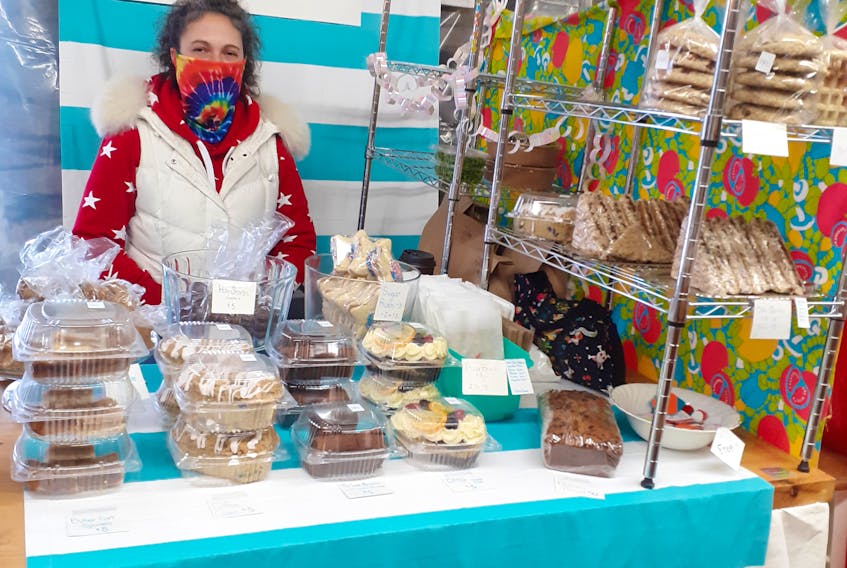A farmers market in the province is in the black despite losing about a third of its annual operating revenue last year due to COVID-19.
“We were closed from mid-March to the first week of June so we had no income for that period of time,” says Carmen Comeau, president of the Yarmouth Farmers’ Community Market.
“When we reopened, our vendors were only at 50 per cent attendance and our visitor traffic was down.”
Late spring and early summer are the make-it-or-break-it times of the year for the non-profit co-operative that typically has 25 to 35 vendors.
“That’s the season that pays for the rest of the year,” says Comeau.
The market has annual revenue of about $31,000. Last year, the lockdowns and business restrictions imposed by governments cost it at least $10,000 in lost revenue, says Comeau.
Late last autumn, she realized things did not look good going into the winter. Staring the organization in the face was an oil bill that was likely to come in at about $4,000.
The co-op also had monthly rent of $1,200, an electricity bill of about $150 per month and the salary of a part-time employee to cover.
In October, Comeau hunkered down with her board of directors.
After about eight years in its current digs at 15 Hawthorne St. and another few years before that in the Canadian Tire parking lot, the market had built up a lot of good will. The non-profit’s directors thought that might be enough for a public appeal to raise funds.
They weren’t wrong.
“Private donors paid for our heating for the winter,” says Comeau.
“One of our councillors gave us $500 out of his own pocket because he wanted to ensure we would be here,” she says.
“What you give, you get back many times over.”
Weez Colburn, known locally as the Chocolate Lady and owner of Carino Confections at the market, created a basket of goodies that was raffled off.
The Coastal Financial Credit Union in Yarmouth stepped up to cover rent for January, February and March.
The credit union also provided two volunteers on market Saturdays to greet people, inform them of the public health protocols, and ask everyone to wear face masks and sanitize their hands.
“We also had some financial assistance from Farmers’ Markets of Nova Scotia for COVID-19 supplies,” says Comeau.
“That was about $100.”
During the shutdown in the spring, the market was able to avail itself of the Canada Emergency Commercial Rent Assistance for about two months. The program allowed tenants of small businesses or non-profits with monthly rents of no more than $50,000 that saw a drop of at least 70 per cent in revenue during the pandemic to pay only 25 per cent of their rent.
The market did not qualify for the Canada Emergency Wage Subsidy and missed out on other government aid because its only employee is part time.
“The provincial government has a lot of things for non-profits but you need to have a full-time employee and we don’t,” says Comeau.
Yarmouth was spared much of the ravages of the pandemic last year and this helped the market.
“I’m really glad that we live where we live because our vendors and customers feel safe,” says Comeau.
“That can change at any time, but so far our vendors and customers have been very supportive.”
During the pandemic, the market was initially restricted to 25 per cent of its usual capacity due to social distancing regulations. It is back up to 50 per cent capacity, allowing it to welcome as many as 400 customers on Saturdays from 9 a.m. to 1 p.m. The maximum number of customers that can be let in at any time has been cut to 20.
Live music is gone. So too is dining inside the post-and-beam building that houses the market, its stone walls on one side and natural wood on the other providing a folksy feel for visitors.
“There’s no eating in because we can’t socially distance people,” says Comeau.
“We have picnic tables outside, and that was great in the summer.”
Just outside the market’s main building is a 400-square-foot structure with a steel roof and windows on all sides. It’s not insulated or heated but this building, the Galleria, is used, particularly during the summer, as a takeout dining area.
Due to the help given to the market through its public appeal, Comeau is confident the co-operative will be able to ride things out for the rest of the year.
“I’m already getting calls from vendors. And our number of customers and vendors will be as normal as can be and that should cover things through the summer,” she says.
“It helps that we get people from the Annapolis Valley coming here because they feel safe.”
The Pivot is a regular feature about an Atlantic Canadian company adapting to new market realities with innovative products, services or strategies. To suggest a business, email: [email protected].









